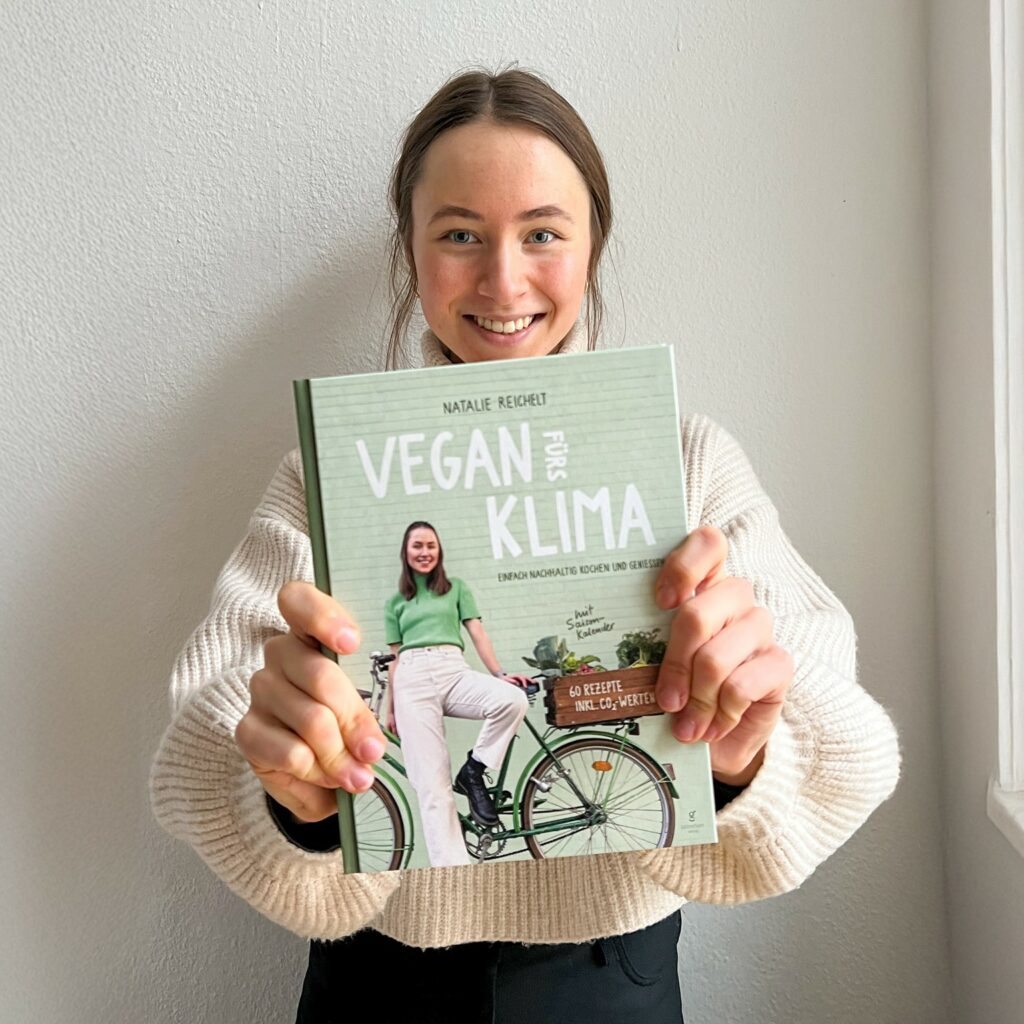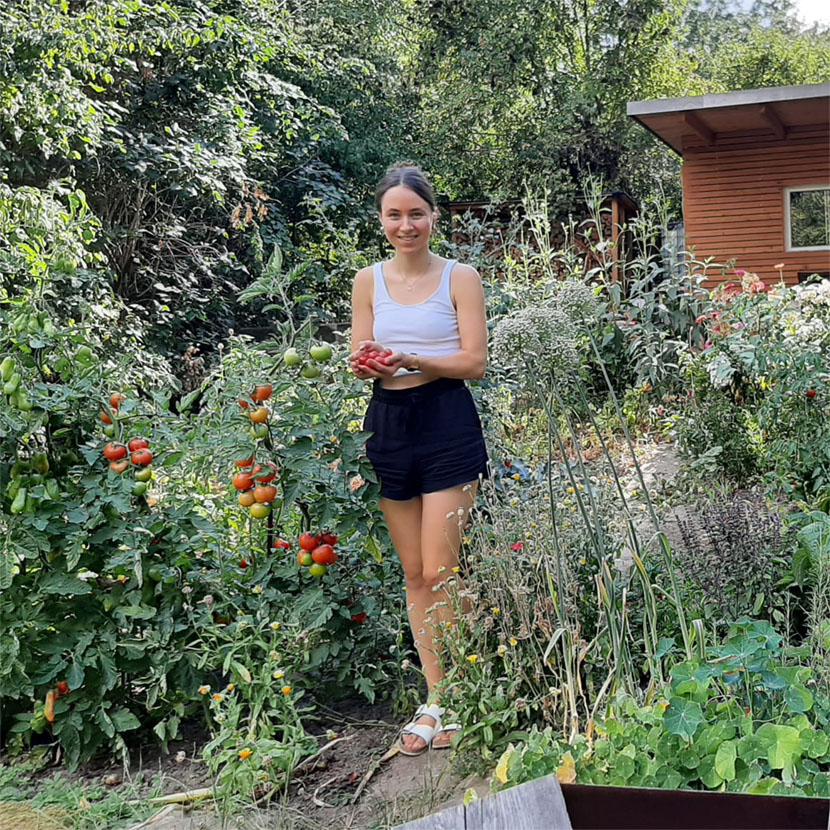VEGAN PERSONALITY
Climate-friendly culinary pleasure – the book


Interview mit Buchautorin Natalie Reichelt
The title of Natalie Reichelt’s innovative new cookbook is Vegan for the Climate (German: “Vegan fürs Klima”). It takes you into the world of regional, seasonal and, of course, purely plant-based cuisine. Natalie Reichelt, a landscape architecture student and blogger from Dresden has for several years now wanted to integrate environmental protection into a modern lifestyle and gourmet cuisine, having been active for the environment for quite some time. She is convinced that you can reach people through delicious plant-based cuisine. In an interview with Velivery, she tells us more about her book, her motivations and what else she is doing. And don’t miss her recipe tips!
VELIVERY: How did the idea for this book come about?
NATALIE: After graduating from high school, I spent a year as an ecological volunteer with the conservation organisation Wilderness International. I worked on rainforest conservation in Canada and became increasingly aware of sustainability and environmental issues. My favourite job was preparing lunch for the whole office, which was always vegetarian and mostly vegan. This year, when I also learned how to calculate carbon footprints, it occurred to me that this method could be used to easily visualise how harmful certain foods are to the climate. It’s a kind of calorie calculator, but instead of showing the number of kilocalories, it shows the amount of greenhouse gases produced by a food. And so I delved deeper and deeper into the many studies on the subject, created my own database, and the idea for my cookbook matured.

Changing a diet for health reasons – and sticking with it for the taste

VELIVERY: How long have you been a vegan and what motivated you to go vegan?
NATALIE: I’ve been on a plant-based diet since 2016. At the time it was all about my health. I suffered from acne and radically changed my diet to a vegan + sugar-free + gluten-free one. After just a few months I started to see results and felt physically fitter. However, as I was eating almost exclusively fruit and vegetables and neglecting healthy fats and carbohydrates, I lost weight far too quickly and slipped into an eating disorder. During my recovery process, I learned what a balanced, healthy diet should look like. For me today, this means living without deprivation and giving the body what it needs. So, I’m going to be open and honest with you here today and tell you that I’m not 100% vegan – I do eat animal products from time to time. However, I live and love a plant-based diet and it’s my mission to share this passion with others.
VELIVERY: As a blogger, you share your knowledge and fresh ideas with others. Where can you be found on Instagram and what is your focus?
NATALIE: On Instagram you can find me at @nataliereichelt. My posts are a colourful mix of plant-based recipes, information on climate-friendly cooking and artistic food photography. In other words, everything I enjoy and where I think I can provide value to my followers.
VELIVERY: What steps in your life led you to become aware of sustainable living and how did you come to write this cookbook?
Understanding the connections thanks to an ecological year
NATALIE: As I said, the first step was to change my diet for health reasons. But during my voluntary ecological year, I received more and more information about sustainability and learned to understand the link between food and our climate. As cooking is my passion and I also care about a healthy environment, I wanted to combine these two things and create an all-inclusive package for sustainable cooking, where I can share my knowledge and show how delicious, simple and healthy an environmentally-friendly diet can be – without sacrificing anything.
VELIVERY: Are you a chef, or where do your creative recipe ideas in the book come from?
NATALIE: I’m not a chef, although I’ve thought about training to be one from time to time over the past few years. I am currently studying landscape architecture and love to be in the kitchen on the side, creating new vegan treats. The inspiration for my recipes comes from non-vegan recipes from my childhood. At the same time, I try to conjure up something new and innovative from the seasonal fruit and vegetables on offer – for example, using swede in a way that makes it popular so that it’s not just known as a food for elephants!
VELIVERY: How complicated is all of this? Can the recipes in your book be cooked by anyone without much cooking experience?

Keep the list of ingredients manageable and avoid exotic ones

NATALIE: My recipes are easy to follow and fun to make. When I was writing the book, it was very important to me to keep the ingredient lists manageable and to avoid exotic ingredients. You can find all the ingredients for my recipes in your local supermarket and they are really cheap because I work with seasonal and regional ingredients. Only a few basic vegan ingredients such as yeast flakes, sulphur salt or Kala Namak and soy sauce should be kept at home.
VELIVERY: What is special about the recipes in your book? Apart from the fact that they’re all vegan, of course.
NATALIE: What is special about them is that I have calculated the CO2 emissions for each recipe and compared them with those of a meat dish. You can see at a glance that the vegan version can save up to 60% of climate-damaging greenhouse gases.
In this way, my book aims to show how easy it is to combine cooking and eating with a green lifestyle. In addition, the book contains an information section on climate-friendly cooking, with graphics by myself that illustrate the topic in a modern way.
VELIVERY: Did you take the photographs for your book and did you contribute to its design? What was important to you in the process?
Almost everything in the book was done by her
NATALIE: Yes, I did. In fact, I did most of the book myself: the content, the recipes, the photos, the seasonal calendar poster and the layout. I only had help with the cover illustration. In designing the whole book, I wanted to present the subject in a modern and contemporary way and to present delicious recipes with their CO2 emissions, so that people would want to cook these plant-based delicacies.
VELIVERY: Who is your book aimed at?
NATALIE: My cookbook is for anyone who is looking for something new and wants to cook and live sustainably!
VELIVERY: What makes your recipes good for the climate? And how does it work?
NATALIE: In my book, I include four recipes for each month. I present regional and seasonal fruits and vegetables in a new way. I also leave out exotic superfoods like chia seeds, avocados and agave syrup and show you local alternatives. These produce less greenhouse gas emissions due to shorter transport routes, which means they have a lower CO2e value and are therefore more climate-friendly

Natalie’s top 3 climate friendly ingredients

VELIVERY: Can you give us your top 3 tips for „climate-friendly“ ingredients, for example in the autumn and winter?
NATALIE:
- Use stored vegetables (potatoes, pumpkins, root vegetables, cabbage, apples, onions).
- Canned foods such as pickled or fermented vegetables, like kimchi, are great for spicing up dishes and are also super healthy.
- Organic citrus fruits and pomegranates from Europe have a lower CO2e value than apples from a store and can be eaten with a clear conscience.
VELIVERY: Sustainability is on the minds of more and more people. What else do you think we can do to live mindfully in this sense? Sinne achtsam zu leben?
Shift down a gear…
NATALIE: I’m a fan of getting back to basics and slowing down in our fast-paced world. For me this includes
- walking or cycling to the shops
- cooking mostly fresh ingredients and doing things myself, like baking bread, fermenting vegetables or growing my own herbs on the windowsill
- showing appreciation and gratitude for the products
- focusing on biodiversity + regionality + seasonality.
But the most important thing for me is that we share with each other and learn from each other, instead of pointing the finger at each other and getting upset about our weaknesses.
VELIVERY: What role do animal welfare, the environment and nature play for you? How do they fit into your daily life and work in this field?m Bereich vorstellen?

NATALIE: Since I started studying landscape architecture, I have been confronted with sustainability issues on a daily basis, and am learning how to plan places so that they become greener and can withstand climate change-related weather events as a holistic system. At the same time, I’m trying to share my knowledge about sustainable food in different ways. For example, I give cooking classes, cooking shows, talks and share my latest favourite recipes on Instagram.
Feast and have fun – Natalie’s advice

VELIVERY: What advice would you give to people who want to start eating more consciously and plant-based? How do you get started?
NATALIE: The best thing to do is to approach it without fear or perfectionism and take a step-by-step approach to a plant-based diet. Nobody becomes a vegan overnight. That’s why I recommend approaching a plant-based lifestyle at your own pace. Every little bit helps, and cooking and baking should be fun!
VELIVERY: Now we’re going to be very bold and ask you to give our readers an exclusive sneak preview of your book. So can you tell us one of your favourite recipes?
NATALIE: Of course! My favourite for autumn and winter is caramelised Brussels sprouts (link to recipe). Because when you roast them in the oven, Brussels sprouts become wonderfully crunchy and taste completely different from traditionally cooked Brussels sprouts. Together with carrots, potatoes, toasted hazelnuts, juicy pomegranate seeds and sugar beet syrup, this is a winter delicacy that will make all your preconceptions about the opinion-dividing Brussels sprout disappear.
VELIVERY: Thank you, Natalie, for your tips and your time.
If you’re now curious about cooking with a climate calculator, especially using fresh seasonal and local ingredients and mega delicious recipes, take a look at Natalie’s book ‚Vegan for the Climate‘. Natalie’s 60 recipes will accompany you through the year. She also provides a calendar for each season.
Here you can test 3 of Natalie’s recipes in advance and enjoy them carefree …
Discover three suitable recipes for the start of autumn

















